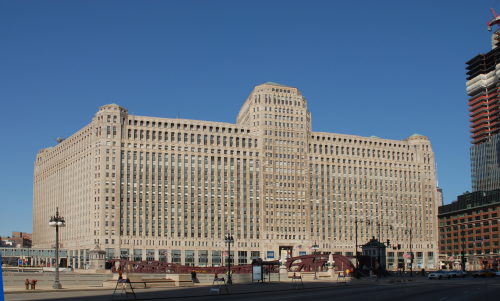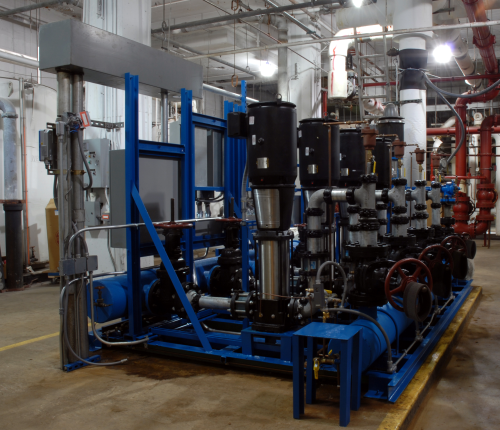

The Merchandise Mart is the world's largest commercial building,largest wholesale design center and one of Chicago's premier international business locations. Encompassing 4.2 million gross ft2, The Mart spans two city blocks and stands 25 stories high. Today, The Merchandise Mart welcomes more than three million visitors each year to its retail shops, boutiques, 11 floors of permanent showrooms for gift, residential, casual and contract furnishings, 10 floors of office space, dozens of trade shows and a myriad of special educational, community and consumer events.
During peak flows, which are typically during a large trade show event or during the working week, demand can reach 750 gallons of water a minute when up to 20,000 people populate the buildingduring major exhibitions. However, during low flows, as witnessed during the early morning hours, demand can slow to a few gallons a minute. With such a wide range of flows and given the Merchandise Mart's demanding show schedule where water consumption constantly changes, the new domestic water system would need to match not only extremely high flow demands but also the low flow demands using the least amount of energy necessary.
When the Merchandise Mart buildingin Chicago began the task of obtaining LEED-EB certification it was the fifth buildingin Chicago to ‘go green’. Adhering to standards set forth by the LEED Green Building Rating System, a voluntary, consensus-based national standard for developing high-performance, sustainable buildings,the Merchandise Mart focused on five key areas of green buildingstrategy: sustainable sites, water efficiency, energy efficiency, materials/resources and indoor environmental quality as set forth by LEED. Such ongoing improvements involved the re-evaluation of capital programmes for the replacement of windows, roofs, controls, plumbing fixtures, utility meters and lighting.
To better target energy efficiency, just one of the many strategies directed by Merchandise Mart's vice president of engineering Mark J Bettin, PE, was to replace an outdated domestic water supply system that was a large consumer of energy and an inefficient supplier of water.
Original system
The original system consisted of five pumps ranging in size from 40 hp to 75 hp. The pumps ran at a constant speed intended for the highest demands even during low-flow periods such as during the middle of the night. The system was designed to deliver over 1250 gpm, churned at 290 psig, and incorporated pressure reducing valves in the discharge of each pump to maintain a system pressure at 200 psig. The five original pumps were oversized by 35 hp each, totaling 175 unnecessary horses.
“With recent restroom renovations complete, the water consumption and demand was reduced annually by over 35%, resulting in an oversized, inefficient pumping system. It required large amounts of energy to run and replacing it would help the building'songoing energy reduction efforts and contribute in maintaining the standards of LEED certification,” Bettin said.
According to Merchandise Mart's plumbing foreman, John Geiss, prior to the retro-fit and during heavy usage the domestic water system would see momentary swings in the system as much as 40 psi at the top end of the system, resulting in noticeable fluctuations at the fixtures and excessive pipe movement.
During the bidding process, quality, service and experience were the criteria important to Bettin when choosing the companies to complete the work. “We pre-qualified the companies such as engineer KJWW, Metropolitan Industries, Inc., Great Lakes Plumbing and Blaze Electric based on their experience and reputation,” he said.
Chicago-based Great Lakes Plumbing was awarded the design/build contract based on the proposal they submitted. Great Lakes’ Bob DeGuiseppe, project manager, served as the general plumbing contractor and pump and control system manufacturer Metropolitan Industries, Inc. of Romeoville, Illinois designed the new system and pressure reducing zone stations while Blaze Electric of Broadview, Illinois served as the installing electrical contractor and KJWW of Chicago served as Engineer during the project.
New green system
Metropolitan's design of the pump system and pressure reducing zone stations was based on two specific goals that included reducing energy costs on day one of start-up and ensuring enough redundancy to prevent loss of service in the future due to power or mechanical issues.
Working closely with DeGuiseppe, Metropolitan Chicago sales manager Mike Ponx suggested installing a variable-speed system that would reduce energy costs by half due to the system's ability to precisely match demand using only the minimal amount of energy necessary. During low flow periods where little or no demand exists, a variable speed system shuts down entirely, saving energy and money while four bladder tanks located in two separate locations help maintain pressure, while the system is in shutdown/low flow mode.
The system supplied was a variable speed, quadraplex booster system using vertical, multi-stage pumps. The total system was rated at 1000 gpm at 200 psi. The Merchandise Mart's peak flows are 750 gallons/minute, so in a condition in which any single pump fails, the system will still be able to handle the load without shut down. To add to the redundancy, there are two separate power feeds divided between the system. Feed A runs three pumps and Feed B runs two pumps. If either feed A or feed B is lost, the buildingwill still have one electrical feed to supply water to the buildingwithout interruption or system shutdown. The electrical control system and plumbing design was also configured so that one existing pump could operate as a manual stand-by pump to further add redundancy to the building.
During low flow periods, usually during the middle of the night, the variable speed system will shut down, eliminating energy consumption while four bladder tanks sustain pressure.
The buildingis divided into four zones to stabilize pressure. At each zone, pressure reducing valves were downsized to maintain each of the zone's pressure requirements and the four bladder tanks were installed on the 6 in cold water express risers to sustain pressure when the system shuts off during low flow periods.
LEED for existing buildings
LEED-EB is a rating system for the sustainable operation and upgrades of existing buildings.LEED-EB improves buildingoperation and performance while reducing overall operating costs, and provides a structure for maintaining performance over the long term. LEED-EB is an effective measure of sustainable buildingoperations, upgrades, and maintenance. It is one tool within a suite of LEED assessment instruments developed by the USGBC to promote market transformation to sustainable buildingand operating practices.
Using bladder tanks at the top of the express riser, pressure is stored so that the system can shut off during low flow periods. As flow is consumed, the pump system will activate and supply water to the buildingat the desired pressure. Once the demand for water is reduced to a low flow period, the system will shut off once again. Significant energy savings are realized during low flow periods when using variable speed drives and bladder tanks in combination.
During installation of the pumps and controls, interruption of service did not occur to the building,said DeGuiseppe. “Since the existing booster system had two independent electrical feeds and the buildingcould not be without water at any time, the electrical controls were built into two sections, which would be mated together during the second phase", he said. DeGuiseppe spilt the new control panel into two sections. Blaze Electric installed the main control section first after disconnecting the first electrical feed, than installed the first two of four pumps using the new controls. Once the first two new pumps were online, Blaze Electric removed the old panel and installed the second half of the new control panel, which was designed to mate up to the first section. Frequently, the remaining two pumps were installed.
Green savings
The energy savings realized using a variable speed booster system are tremendous. In order to commission the system and measure the savings, meters were installed to measure flow and energy consumption. Energy reduction in the first week was 34%. With completion of all the pumps, the bladder tanks came on line and the system was set for commissioning. Utilizing a system by-pass and real-time flow meter, various loads were created to allow for fine tuning of the drives and staging of pumps. With the removal of the top zone PRV, the system pressure was successfully lowered from 200 to 185. Taking advantage of the bladder tanks, the night-time mode was enabled, resulting in the cycling of pumps. Week after week evaluation has shown a reduction in energy by up to 50% with an anticipated annual energy reduction of over 125,000 kw/h.
"Within a decade, the system will pay for itself entirely on energy savings and the expected life of this system is over 25-30 years, so eventually the system will not only pay for the end-user for the cost of the system but it will also pay for the costs to replace itself in its lifetime!
Conclusion
According to Geiss, completion of the retro-fit work improved the overall performance of the system by lowering working pressure and reducing fluctuations throughout the system. “For the first time we have experienced the most even flow and the best overall psi performance at the top of the 10th, 18th and 25th floor zones,” he said.
This was accomplished by reducing the size of the valves in the respective zones to ‘tighten' up the flow in conjunction with the smooth operation of the variable speed booster system and bladder tanks that feed and assist the entire system as a whole.
“Overall Metropolitan and all parties involved came through with the promise and commitment to a 2-4 psi swing, and an energy savings that will match the Merchandise Mart's committed effort to LEED providing for a GREENER tomorrow,” said Geiss.





